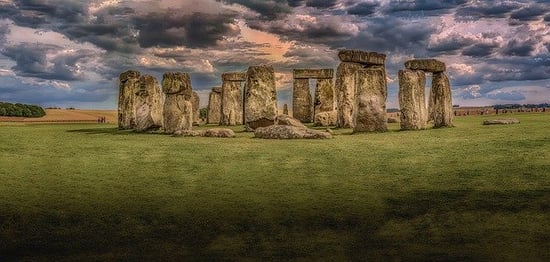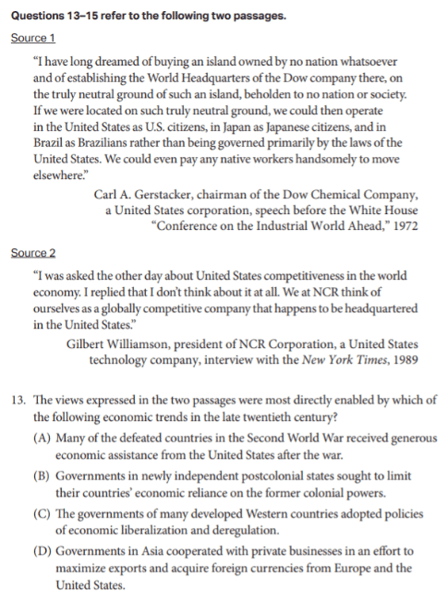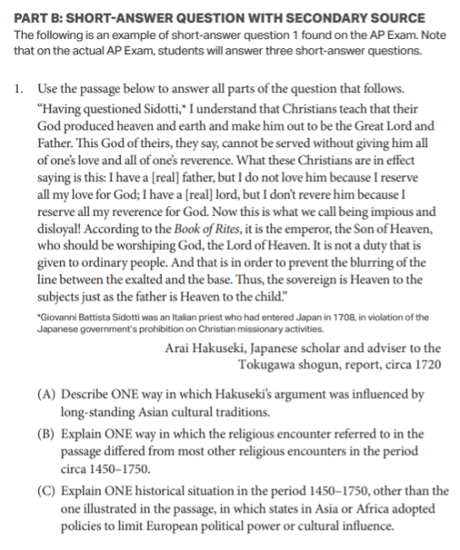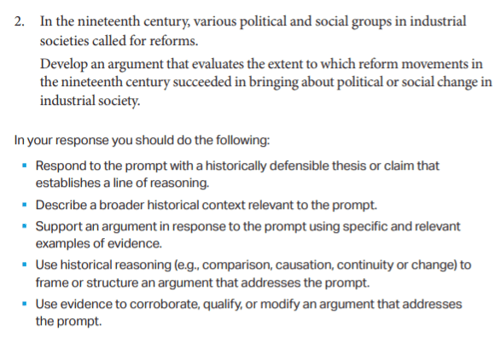
Before you start studying for the AP World History exam, you should get the inside scoop on its format and content. The types of questions you'll see might differ from your expectations. It's especially smart to practice writing essay outlines based on past questions before you're faced with fresh prompts on test day.
In this article, we'll go through the structure, content, and question types on the AP World History exam and provide some helpful tips for acing it!

2021 AP Test Changes Due to COVID-19
Due to the ongoing COVID-19 coronavirus pandemic, AP tests will now be held over three different sessions between May and June. Your test dates, and whether or not your tests will be online or on paper, will depend on your school. To learn more about how all of this is going to work and get the latest information on test dates, AP online review, and what these changes means for you, be sure to check out our 2021 AP COVID-19 FAQ article.
How Is the AP World History Exam Structured?
The AP World History exam is three hours and 15 minutes and consists of two sections, each of which contains a Part A and a Part B. Here's a basic overview of these sections before we get into the nitty-gritty below:
- Section 1, Part A: Multiple Choice
- Section 1, Part B: Short Answer
- Section 2, Part A: Document-Based Question (DBQ)
- Section 2, Part B: Long Essay
It should be noted that the AP World History exam has undergone some big changes for the 2019-20 school year. Instead of covering thousands of years of human history and development, now it will cover only the years 1200 to the present; as a result, the exam has been renamed AP World History: Modern (an AP World History: Ancient course and exam are in the works).
Section 1 Format
Section 1 on the AP World History exam lasts a total of 95 minutes and consists of two parts:
- Part A: Multiple Choice
- Part B: Short Answer
This chart shows what you can expect for each part of Section 1 on the World History exam:
| Section 1 | Question Type | Time | # of Questions | % of Score |
| Part A | Multiple Choice | 55 mins | 55 | 40% |
| Part B | Short Answer | 40 mins | 3 (for third, choose 1 of 2 prompts) | 20% |
| TOTAL | — | 95 mins | 58 | 60% |
Part A lasts 55 minutes and counts for 40% of your total AP World History score. Each question on this part comes with four possible answer choices (labeled A-D). Since there are no penalties for wrong answers, it's in your best interest to fill in an answer for every question.
Most multiple-choice questions come in sets of three to four questions and require you to analyze primary and secondary sources as well as data in the form of graphs, charts, maps, etc.
Part B lasts 40 minutes and counts for 20% of your final AP score. For this section, you must write three short answers (you'll get four prompts in total, but you choose one of two prompts to write on for your third essay). You'll have different sources, or stimuli, for each short-answer prompt:
- Short Answer 1: Includes one secondary source
- Short Answer 2: Includes one primary source
- Short Answer 3/4 (choose one prompt): No stimulus for either option; prompt 3 focuses on the years 1200-1750, while prompt 4 focuses on the years 1750-2001
Section 2 Format
Section 2 on the AP World History test lasts 100 minutes and, like Section 1, consists of two parts:
- Part A: Document-Based Question (DBQ)
- Part B: Long Essay
Here's a brief overview of the format of Section 2 of the World History exam:
| Section 2 | Question Type | Time | # of Questions | % of Score |
| Part A | Document-Based Question | 60 mins (including a 15-min reading period) | 1 | 25% |
| Part B | Long Essay | 40 mins | 1 (choose 1 of 3 prompts) | 15% |
| TOTAL | — | 100 mins | 2 | 40% |
Part A in Section 2 lasts one hour and counts for 25% of your total score. For the Document-Based Question, or DBQ, you'll get seven documents offering different viewpoints on a certain historical development. You must write an essay with an argument supported by this historical evidence.
Part B, which is the Long Essay, lasts for just 40 minutes and counts for 15% of your AP score. This part of the test requires you to write a full-fledged essay in response to one of three prompts (you choose which one you want to write on). Unlike the DBQ, you're not given any direct historical evidence to use in your essay; you must come up with it yourself to support your argument.
Here are the three types of prompts you can choose from for the Long Essay:
- Prompt 1: Focuses on the years 1200-1750
- Prompt 2: Focuses on the years 1450-1900
- Prompt 3: Focuses on the years 1750-2001
 Sadly, Stonehenge won't be tested on the exam. But, hey, at least its picture made it into this article!
Sadly, Stonehenge won't be tested on the exam. But, hey, at least its picture made it into this article!
What Kind of Content Is Covered in AP World History?
Content on the AP World History exam is divided into six overarching themes and nine distinct units. Knowing these categorizations can help you get a better sense of what kinds of historical trends you will be asked to examine (this is especially helpful when writing free-response essays!). The units are roughly divided up into overlapping periods of time.
Below, we introduce the current themes and units, as described in the 2019-20 AP World History: Modern Course and Exam Description.
The 6 Themes in AP World History
Let's start by looking closely at the six major themes covered on the AP World History exam.
Theme 1: Humans and the Environment
The environment shapes human societies, and as populations grow and change, these populations in turn shape their environments.
Key points:
- Demography and disease
- Migration
- Patterns of settlement
- Technology
Theme 2: Cultural Developments and Interactions
The development of ideas, beliefs, and religions illustrates how groups in society view themselves, and the interactions of societies and their beliefs often have political, social, and cultural implications.
Key points:
- Religions and cultures
- Belief systems, philosophies, and ideologies
- Science and technology
- The arts and architecture
Theme 3: Governance
A variety of internal and external factors contribute to state formation, expansion, and decline. Governments maintain order through a variety of administrative institutions, policies, and procedures, and governments obtain, retain, and exercise power in different ways and for different purposes.
Key points:
- Political structures and forms of governance
- Empires
- Nations and nationalism
- Revolts and revolutions
- Regional, transregional, and global structures and organizations
Theme 4: Economic Systems
As societies develop, they affect and are affected by the ways that they produce, exchange, and consume goods and services.
Key points:
- Agricultural and pastoral production
- Trade and commerce
- Labor systems
- Industrialization
- Capitalism and socialism
Theme 5: Social Interactions and Organization
The process by which societies group their members and the norms that govern the interactions between these groups and between individuals influence political, economic, and cultural institutions and organization.
Key points:
- Gender roles and relations
- Family and kinship
- Racial and ethnic constructions
- Social and economic classes
- Slavery and abolition
Theme 6: Technology and Innovation
Human adaptation and innovation have resulted in increased efficiency, comfort, and security, and technological advances have shaped human development and interactions with both intended and unintended consequences.
Key points:
- Intellectual innovation
- Transportation technologies and trade
- Travel
- Modes of production and machinery
- Communication

The 9 Units in AP World History
Here, we'll go over the nine units of the AP World History course and exam. But before we describe each one in depth, here's a quick overview of how these units are tested:
| AP World History Unit | Time Period | % of Exam |
| Unit 1: The Global Tapestry | 1200-1450 | 8-10% |
| Unit 2: Networks of Exchange | 8-10% |
| Unit 3: Land-Based Empires | 1450-1750 | 12-15% |
| Unit 4: Transoceanic Interconnections | 12-15% |
| Unit 5: Revolutions | 1750-1900 | 12-15% |
| Unit 6: Consequences of Industrialization | 12-15% |
| Unit 7: Global Conflict | 1900-present | 8-10% |
| Unit 8: Cold War and Decolonization | 8-10% |
| Unit 9: Globalization | 8-10% |
Source: AP World History Course and Exam Description, 2019-20
Unit 1: The Global Tapestry (1200-1450)
- Developments in East Asia from c. 1200 to c. 1450
- Developments in Dar al-Islam from c. 1200 to c. 1450
- Developments in South and Southeast Asia from c. 1200 to c. 1450
- State Building in the Americas
- State Building in Africa
- Developments in Europe from c. 1200 to c. 1450
- Comparison in the period from c. 1200 to c. 1450
Unit 2: Networks of Exchange (1200-1450)
- The Silk Roads
- The Mongol Empire and the making of the modern world
- Exchange in the Indian Ocean
- Trans-Saharan trade routes
- Cultural consequences of connectivity
- Environmental consequences of connectivity
- Comparison of economic exchange
Unit 3: Land-Based Empires (1450-1750)
- Empires expand
- Empires: administration
- Empires: belief systems
- Comparison in land-based empires
Unit 4: Transoceanic Interconnections (1450-1750)
- Technological innovations from 1450 to 1750
- Exploration: causes and events from 1450 to 1750
- Columbian exchange
- Maritime empires established
- Maritime empires maintained and developed
- Internal and external challenges to state power from 1450 to 1750
- Changing social hierarchies from 1450 to 1750
- Continuity and change from 1450 to 1750
Unit 5: Revolutions (1750-1900)
- The Enlightenment
- Nationalism and revolutions in the period from 1750 to 1900
- Industrial Revolution begins
- Industrialization spreads in the period from 1750 to 1900
- Technology of the Industrial Age
- Industrialization: government's role from 1750 to 1900
- Economic developments and innovations in the Industrial Age
- Reactions to the industrial economy from 1750 to 1900
- Society and the Industrial Age
- Continuity and change in the Industrial Age
Unit 6: Consequences of Industrialization (1750-1900)
- Rationales for imperialism from 1750 to 1900
- State expansion from 1750 to 1900
- Indigenous responses to state expansion from 1750 to 1900
- Global economic development from 1750 to 1900
- Economic imperialism from 1750 to 1900
- Causes of migration in an interconnected world
- Effects of migration
- Causation in the Imperial Age
Unit 7: Global Conflict (1900-Present)
- Shifting power after 1900
- Causes of World War I
- Conducting World War I
- The economy in the interwar period
- Unresolved tensions after World War I
- Causes of World War II
- Conducting World War II
- Mass atrocities after 1900
- Causation in global conflict
Unit 8: Cold War and Decolonization (1900-Present)
- Setting the stage for the Cold War and decolonization
- The Cold War
- Effects of the Cold War
- Spread of communism after 1900
- Decolonization after 1900
- Newly independent states
- Global resistance to established order after 1900
- End of the Cold War
- Causation in the age of the Cold War and decolonization
Unit 9: Globalization (1900-Present)
- Advances in technology and exchange after 1900
- Technological advances and limitations after 1900: disease
- Technological advances: debates about the environment after 1900
- Economics in the Global Age
- Calls for reform and responses after 1900
- Globalized culture after 1900
- Resistance to globalization after 1900
- Institutions developing in a globalized world
- Continuity and change in a globalized world
 Unfortunately, we still have a ways to go in accepting the devastating impact we've had on the environment. Remember when a congressperson threw a snowball in the House of Representatives in an attempt to prove that global warming doesn't exist? We're doomed.
Unfortunately, we still have a ways to go in accepting the devastating impact we've had on the environment. Remember when a congressperson threw a snowball in the House of Representatives in an attempt to prove that global warming doesn't exist? We're doomed.
Sample AP World History Test Questions
Let's go through examples of each of the four types of questions you'll see on the AP World History exam. All sample questions come from the 2019-20 World History Course and Exam Description.
Multiple-Choice Question Example

Most multiple-choice questions come in sets of three to four questions that ask you to respond to a particular source, or stimulus, such as a primary source, a secondary source, or data in the form of a map, chart, or table.
In this sample question, you're being asked to read and interpret two separate passages. You must have background knowledge of economic trends in the late 20th century to be able to select the correct answer here (which is answer choice C).
Short-Answer Question Example

This short-answer question is accompanied by a secondary source. In each short-answer question on the test, each part (A-C) should only require a one- to two-sentence answer. You'll then get 1 point per correct response (so the max you can earn on one short-answer question is 3 points).
Here's how you could earn full credit for this question, per the official scoring guidelines.
(A) Sample Answers
- Hakuseki's argument was influenced by Confucianism.
- Hakuseki's argument that sovereign is Heaven to the subjects and the father is Heaven to the child was influenced by Confucian beliefs.
- Hakuseki's argument that only the emperor is supposed to serve the Lord of Heaven reflects the beliefs of Confucianism.
(B) Sample Answers
- One important difference is that most Christian missionaries and Muslim Sufis traveled across the world and spread their religion without being banned by other governments.
- One important difference between the circumstances of the religious encounter in eighteenth century Japan and other religious encounters in the period 1450–1750 is that religious interactions in this period more frequently led to the development of syncretic belief systems such as Vodou or Santería than the outright banning of the preaching of a religion.
- One important difference between the Tokugawa shogunate banning the preaching of Christianity and most other religious interactions in the period 1450–1750 is that some governments, such as the Mughal Empire under Akbar, encouraged religious tolerance and interaction.
(C) Sample Answers
- The Mughal emperors of India and the African kings of Kongo attempted to restrict European merchants to certain towns and trading posts.
- The Ming and Qing emperors of China confined the Portuguese merchants to Macao and placed legal restrictions on converting to Christianity.
- Although the Safavid Empire allowed European merchants to settle in some cities and even serve as advisors at court, preaching Christianity was strictly forbidden.
 This next question type requires you to dig deep into history, preferably with a cool magnifying glass.
This next question type requires you to dig deep into history, preferably with a cool magnifying glass.
Document-Based Question Example

You'll get seven documents with your DBQ (not shown in the sample above), and you must use at least six of these as evidence in your response. The DBQ is worth up to 7 points.
Here's what you'd need to do to earn full credit for this sample DBQ, per the scoring guidelines.
| Rubric | How to Earn Full Credit | Sample Response |
Thesis/Claim
(0-1 points) | The response must provide a historically defensible thesis or claim that establishes a position on the extent to which the experience of the First World War changed relationships between Europeans and colonized peoples; the thesis or claim must either provide some indication of the reason for making that claim OR by establishing categories of the argument | "The experience of the First World War greatly changed the relationship between Europeans and colonized peoples because the war showed that Europeans needed colonial troops to fight their wars." |
Contextualization
(0-1 points) | Must accurately describe a context relevant to the First World War or interactions between Europeans and colonized peoples before or during the First World War (nineteenth and early twentieth centuries) | "Both Great Britain and France had long recruited local troops in their colonies and had used them to suppress revolts and expand their colonial empires. When World War I started, it was pretty clear that it will be a 'total war' requiring all the resources countries could muster—so it was a foregone conclusion that these colonial armies will be used, whether on European fronts or in Asia and Africa." |
Evidence
(0-3 points) | 2 points: Support an argument in response to the prompt by accurately using the content of at least six documents; the six documents do not have to be used in support of a single argument, but they can be used across subarguments or to address counterarguments 1 point: Must use at least one specific piece of historical evidence relevant to an argument about the extent to which there were changes in relationships between European and colonized people that resulted from the First World War | (Document 1): "John Chilembwe's letter to the Nyasaland Times shows that Europeans' need for African recruits has changed the relationship between colonizers and colonial peoples because the British in Nyasaland now have to appeal to Africans' sense of duty and patriotism. But, after seeing how Europeans have treated their colonial subjects in peacetime, Chilembwe isn't buying it."
"Many colonized people had hoped that after the end of the war they would be rewarded by their service by giving them fuller citizenship rights, if not outright independence. But the peace treaties left the British and French empires untouched and actually expanded them through the Mandate system." |
Analysis and Reasoning
(0-2 points) | 1 point: Must explain how or why—rather than simply identifying—the document's point of view, purpose, historical situation, or audience is relevant to an argument that addresses the prompt for each of the three documents sourced 1 point: Must demonstrate a complex understanding, such as by explaining nuance of an issue by analyzing multiple variables, or by explaining relevant and insightful connections within and across periods | (Document 1): "As an ordained minister, John Chilembwe is probably opposed to wars in general, but in the case of the First World War he is particularly against the idea of Africans serving because he can see that there is no higher purpose to the war than European political and economic gain." |
Looking for help studying for your AP exam?
Our one-on-one online AP tutoring services can help you prepare for your AP exams. Get matched with a top tutor who got a high score on the exam you're studying for!

Long Essay Question Example

For the Long Essay, you'll get three possible prompts to choose from. This question is an example of an Option 2 prompt with a focus on the years 1450-1900—in this case, the 19th century. You can earn up to 6 points for your essay.
Here's what you'd need to do to earn full credit for this sample, per the official scoring guidelines:
| Rubric | How to Earn Full Credit | Sample Response |
Thesis/Claim
(0-1 points) | The response must provide a historically defensible thesis or claim about the extent to which reform movements succeeded in bringing about political or social change in industrial society in the nineteenth century. The thesis or claim must either provide some indication of the reasoning for making that claim OR by establishing analytic categories of the argument | "Nineteenth-century reform movements were somewhat successful in bringing about political change in industrial societies because more people received the right to vote." |
| Contextualization
(0-1 points) | Must accurately describe a context relevant to reform movements or industrial society in the nineteenth century | "Advances in agriculture in Europe allowed for an increase in mechanization in the manufacturing of goods. This industrial revolution spread across Europe and to North America and led to challenges to traditional social and political structures." |
Evidence
(0-2 points) | Must use at least two specific historical
evidence examples to support an argument regarding how reform movements brought about political or social change in industrial society in the nineteenth century | "During the nineteenth century, most governments of industrial societies successfully resisted adopting most of the demands of political and social reform movements. For example, the British government adopted very few of the Chartist demands, such as annual elections for Parliament, and minimum wage and eight-hour work day laws were only enacted in the twentieth century in most industrialized states." |
| Analysis and Reasoning
(0-2 points) | Must demonstrate a complex understanding, such as by explaining nuance of an issue by analyzing multiple variables, or by explaining relevant and insightful connections within and across periods | N/A |

How Is the AP World History Exam Scored?
Now that you've seen what questions look like on the AP World History test, let's quickly go over exactly how the exam is scored. Like all other AP tests, you will get a final scaled score for AP World History on a scale of 1-5. This is a cumulative score that combines your raw scores from each of the four parts of the test (Multiple Choice, Short Answer, DBQ, and Long Essay).
Keep reading to see how each part of the AP World History test is scored.
Multiple Choice
Raw scoring for the multiple-choice section is simple: you earn 1 point for each multiple-choice question you answer correctly. Since there are 55 questions, the max number of points you can earn here is 55. Remember that this part counts for 40% of your total score.
No points are taken off for incorrect answers, so be sure to fill in every answer bubble!
Short Answer
Each short-answer question is worth 3 points—one for each task (labeled A-C) you must complete. Because there are three short-answer questions, this means you can earn a total of 9 raw points for all your responses. The short-answer portion counts for 20% of your final AP score.
Document-Based Question
The DBQ is worth 25% of your final score and is graded on a 7-point rubric, as shown below:
| Skill Name | Rubric Description |
Thesis/Claim
(0-1 points) | 1 point: Responds to the prompt with a historically defensible thesis/claim that establishes a line of reasoning |
Contextualization
(0-1 points) | 1 point: Describes a broader historical context relevant to the prompt |
Evidence
(0-3 points) | 2 points (evidence from the documents): Supports an argument in response to the prompt using at least six documents 1 point (evidence beyond the documents): Uses at least one additional piece of the specific historical evidence (beyond that
found in the documents) relevant to an argument about the prompt |
Analysis and Reasoning
(0-2 points) | 1 point (sourcing): For at least three documents, explains how or why the document's point of view, purpose, historical situation, and/or audience is relevant to an argument 1 point (complexity): Demonstrates a complex understanding of the historical development that is the focus of the prompt, using evidence to corroborate, qualify, or modify an argument that addresses the question |
Long Essay
The Long Essay is worth just 15% of your overall score and is graded on a 6-point rubric:
| Skill Name | Rubric Description |
Thesis/Claim
(0-1 points) | 1 point: Responds to the prompt with a historically defensible thesis/claim that establishes a line of reasoning |
Contextualization
(0-1 points) | 1 point: Describes a broader historical context relevant to the prompt |
Evidence
(0-2 points) | 2 points: Supports an argument in response to the prompt using specific and relevant examples of evidence |
Analysis and Reasoning
(0-2 points) | 2 points: Demonstrates a complex understanding of the historical development that is the focus of the prompt, using evidence to corroborate, qualify, or modify an argument that addresses the question |
The Best Way to Prep for the AP World History Exam: 3 Tips
Here are a few of the most important prep tips for AP World History. If you want more advice, take a look at our article on the best study strategies for this exam.
Tip 1: Make Connections to Themes (and Memorize Examples)
World History is a course that covers a ton of information, so much so that it can be hard to think of specific examples that relate to your arguments in essay questions. You should be able to elaborate on one or two concrete events from each period that relate to each theme of the course.
As long as you can preserve this bank of information in your mind, you'll be able to support your answers to any essay questions the test throws at you.
Tip 2: Use Outside Information Selectively
Providing specific historical examples in your essay lets you show your mastery of the material, but you need to be cautious. This test is less about how much you know and more about how well you understand the connections and underlying themes that connect historical facts.
Each fact you mention must have a specific purpose and should tie directly into what the question is asking and what you've stated in your argument.
Tip 3: Learn to Read Multiple-Choice Questions Carefully
You can get into some trouble if you don't understand exactly what the multiple-choice questions are asking on this exam. You'll only find the correct answer if you stick to the specifics of the question. Otherwise, you could get tripped up by choices that are accurate statements about history but inaccurate answers to the question being asked.
Practice your skills in selecting answers that directly pertain to the evidence presented in the question.
 STICK to the specifics of the question! Also, I admire the sacrifices this woman made for the sake of a stock photo, both in terms of her dignity and in terms of the pain she must have experienced when ripping that tape out of her hair.
STICK to the specifics of the question! Also, I admire the sacrifices this woman made for the sake of a stock photo, both in terms of her dignity and in terms of the pain she must have experienced when ripping that tape out of her hair.
Summary: What to Know About the AP World History Exam
The AP World History exam is a three-hour and 15-minute test that consists of 55 multiple-choice questions, three short answers, one DBQ, and one essay.
Questions address six major historical themes and nine units, with periods stretching back to the year 1200 CE. While this is undoubtedly a lot of information to study, it's important to realize that long-term trends are more important than small details.
You can do extremely well on the World History test, as long as you master the major events of each period and understand their essential causes and effects.
What's Next?
Looking for some practice materials for the World History exam? Then check out this detailed guide to all the AP World History practice tests available online.
It's a smart idea to practice your writing skills on DBQs before any AP history test. Learn about the best places to find DBQ examples and how you can write an excellent response.
Which AP classes should you take in high school besides World History? Our expert guide will help you decide based on your goals, academic interests, and schedule.
One of the single most important parts of your college application is what classes you choose to take in high school (in conjunction with how well you do in those classes). Our team of PrepScholar admissions experts have compiled their knowledge into this single guide to planning out your high school course schedule. We'll advise you on how to balance your schedule between regular and honors/AP/IB courses, how to choose your extracurriculars, and what classes you can't afford not to take.



 Sadly, Stonehenge won't be tested on the exam. But, hey, at least its picture made it into this article!
Sadly, Stonehenge won't be tested on the exam. But, hey, at least its picture made it into this article! 
 Unfortunately, we still have a ways to go in accepting the devastating impact we've had on the environment. Remember when a congressperson threw a snowball in the House of Representatives in an attempt to prove that global warming doesn't exist? We're doomed.
Unfortunately, we still have a ways to go in accepting the devastating impact we've had on the environment. Remember when a congressperson threw a snowball in the House of Representatives in an attempt to prove that global warming doesn't exist? We're doomed. 

 This next question type requires you to dig deep into history, preferably with a cool magnifying glass.
This next question type requires you to dig deep into history, preferably with a cool magnifying glass. 



 STICK to the specifics of the question! Also, I admire the sacrifices this woman made for the sake of a stock photo, both in terms of her dignity and in terms of the pain she must have experienced when ripping that tape out of her hair.
STICK to the specifics of the question! Also, I admire the sacrifices this woman made for the sake of a stock photo, both in terms of her dignity and in terms of the pain she must have experienced when ripping that tape out of her hair. 

0 Response to "Chapter 8 Guided Reading Questions Ap World History"
Post a Comment